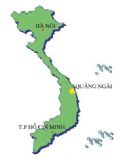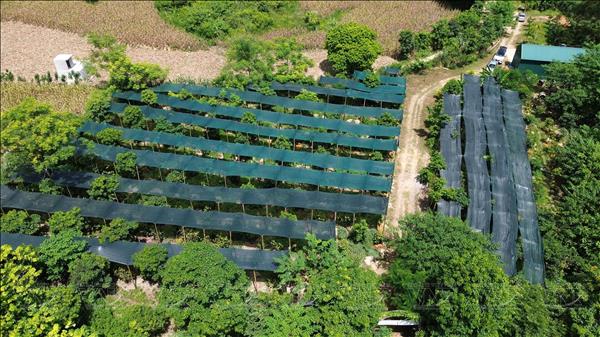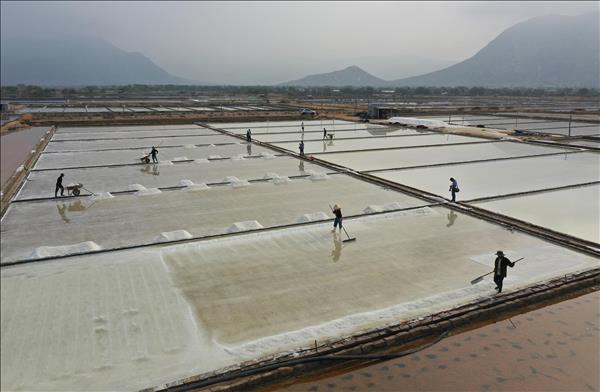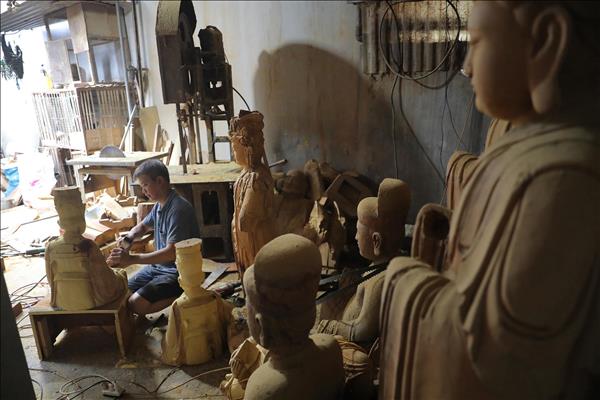|
|

Hoang Son, Vice
Chairman of Quang Ngai Province People’s Committee: “We will
try our best to
complete construction
at Dung Quat and put
it into operation.”nbsp;nbsp;nbsp;nbsp;

The newly-built bridge linking Quang Ngai Town with Dung Quat area.

On the construction
site of Dung Quat
Oil Refinery.

Building infrastructure
for Dung Quat
Industrial Zone.nbsp;

In an electricity
training class.

Dung Quat Vocational Training School can
supply trained workers
and technicians to factories and plants in Dung Quat economic area.nbsp;

In an electronic-IT class.nbsp;

Dung Quat garment making enterprise was
put into operation.

The Hollow Bricks
Factory supplies construction materials
to the entire Dung
Quat economic area.
|
Located in the poor area of Quang Ngai, 860 km away from both Hanoi Capital in the North and Ho Chi Minh City in the South, Dung Quat area has been zoned off and become the focus in the economic development strategy of Central Vietnam and the third biggest economic centre of the country.nbsp;
Le Van Dung, Director of the information and investment promotion centre under Dung Quat Management Board started his conversation with us by providing attractive information: The Vietnamese Government has decided to turn Dung Quat area into a general economic zone with multi sectors and branches developed and investment priorities given at the highest level. This area also enjoys open administrative structure and regulations in accordance with international rules and the current economic globalization.
In the western industrial zone covering an area of 1,400 ha, light industrial projects will be developed, including the electric and electronic sectors, high-tech materials, textile and garment, agricultural, forestry, aquatic-sea product processing, as well as consumer goods for domestic use and export.
At the deep-water port, a 1,600-m breakwater and a 1,750-m sand guard dyke are under construction to make the port a close and safe one that can accommodate ships of up to 50,000 DWT.
Next to Dung Quat port is a 310-ha protective tariff zone with many big warehouses under construction, which will operate as an open economic zone in terms of management structure.nbsp;
We stopped for a long time at two areas where infrastructure for Van Tuong urban area covering 2,400 ha and a marine ecological tourist area is being rapidly built. It includes offices, trade, financial, cultural and service centres and modern residential quarters for the local and foreign workers and experts.
The high-rise building of the Management Board is situated on a hill, but from its top we could not have a panoramic view of Dung Quat economic zone. Van Tuong urban area stretches with concrete roads winding their ways amidst the foundations of houses. New projects are emerging, such as a digital television station, an international hospital with 300 beds, a multi-functional cultural and sport centre and an environmental observation centre. In particular, Dung Quat Vocational Training School built in 2001 is of a large and modern scale. Every year, it enrolls 2,000 long-term students and 1,000 short-term students (excluding a university-level course in business management). The School has provided construction and production facilities in Dung Quat area with thousands of skilled workers in various fields, such as bricklaying, blacksmithing, moulding, welding, hydro-machine repairing, mechanical assembly, aerodynamics, electrics and electronics, petro-chemical refinery, port services, industrial tailoring, fire prevention and fighting, and professional guards.
At Saigon- Dung Quat Industrial Sub-Zone on an area of 108 ha, which is reserved for investors from Ho Chi Minh City (who are natives of Quang Ngai Province), all facilities have been occupied. The factories of garments, forestry produce processing for export and pre-cast concrete are working at full capacity and have high effeciency in production and trade. Production and construction activities at Dung Quat area create a boisterous and bustling atmosphere everywhere.nbsp;
Seeing the geographical map of Dung Quat area we can perceive the deep economic knowledge of the planners. Lying amidst international routes, Dung Quat is a starting point of one of the trans-Asia routes linking Vietnam with Laos, Cambodia and Thailand along the East-West corridor. It is located in the centre of National Highway 1A and the trans-Vietnam railway, adjacent to Chu Lai Airport, which has been modernised to accommodate all categories of planes, and is 190 km away from international maritime lines and on the routes to Hong Kong, Taiwan, Japan, Singapore and the Philippines.
Dung Quat area is still under hectic construction, however we can imagine the day this huge industrial zone is completed and operates as the third biggest economic centre of the country.
No one else can understand better than Dung Quat residents that by building a key economic zone of great significance to the political, economic and social life of the whole central area, the Vietnamese State has brought many opportunities for this poor land to prosper.
|
Quang Ngai Province: nbsp;nbsp;nbsp;
Area: 5,177 sq. km
Population: 1.3 million people
Ethnic groups: The Viet (Kinh), H’re, Cor and Cadong.
Administrative units: Quang Ngai Town and 12 districts including Ly Son, Binh Son, Tra Bong, Son Tinh, Son Tay, Son Ha, Tu Nghia, Nghia Hanh, Minh Long, Mo Duc, Duc Pho and Ba To.
Geography: Quang Ngai Province is located in the central area of the country (860 km away from Hanoi Capital in the North and Ho Chi Minh City in the South). Leaning against Truong Son Range at the back and looking towards the East Sea, it borders Quang Nam Province in the North, Binh Dinh Province in the South and Kon Tum Province in the Southwest.
It has 126,605 ha of forests with a reserve of 10 million cubic metres of timber, nearly 150 km of coastline and 11,000 sq. km of fishing ground, a great potential for aqua-culture and catching to meet domestic needs and for export.
Climate: Average temperature of 25.50C- 26.50C.nbsp;nbsp;
nbsp;nbsp;
|
Story: Van Chucnbsp;
Under his guidance, we took a ride in our car to visit this economic area.In the eastern industrial zone covering an area of 1,500 ha reserved for heavy industry, several large-scale plants are being built, such as the Oil Refinery No.1 (capitalized at USD 1.5 billion), the chemical plants (Lab, Polypropylen, Carbon Black, Radial Tyre, etc.), the shipbuilding complex, the plants of steel lamination, engine assembly, heavy mechanical engineering, cement production, automotive manufacture and assembly, with a total licensed investment reaching USD 2.5 billion in early 2005.nbsp; |














